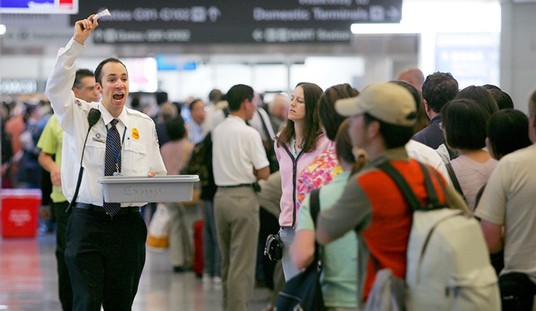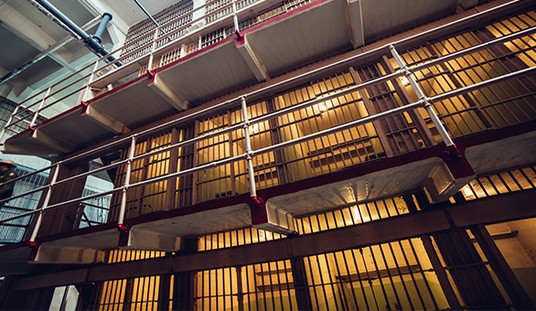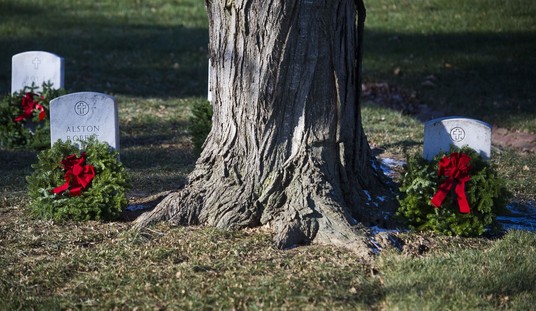
A protester waves a U.S. flag as hundreds of protesters gather outside Kwai Chung police station in Hong Kong, Tuesday, July 30, 2019. Protesters clashed with police again in Hong Kong on Tuesday night after reports that some of their detained colleagues would be charged with the relatively serious charge of rioting. (AP Photo/Vincent Yu)
Right now the people of Hong Kong are engaged in a low level, and so far peaceful, resistance to the attempt by Beijing to assert more control over the former British protectorate.The proximate cause of the unrest was an attempt by Hong Kong’s puppet government to push a bill through the legislature that would allow for the extradition of people in Hong Kong to the mainland. I’m not going to pretend to be an expert on China, even on the internet, so this is a general overview of how we got to where we are today:
February – Hong Kong’s Security Bureau submits a paper to the city’s legislature proposing amendments to extradition laws that would provide for case-by-case extraditions to countries, including mainland China, beyond the 20 states with which Hong Kong already has treaties.
March – Thousands take to the streets of Hong Kong to protest against the proposed extradition Bill. The American Chamber of Commerce expresses serious reservations in a submission to Hong Kong’s Secretary for Security, John Lee. It says the Bill will “undermine perceptions of Hong Kong as a safe and secure haven for international business operations”.
Apr 3 – Carrie Lam’s government introduces amendments to Hong Kong’s extradition laws that would allow criminal suspects to be sent to mainland China for trial. Opponents say the changes would put them at the mercy of Chinese courts.
Apr 28 – Tens of thousands of people march on Hong Kong’s parliament to demand the scrapping of the proposed extradition laws.
May 11, 2019 – Scuffles break out in Hong Kong’s legislature between pro-democracy lawmakers and those loyal to Beijing over the extradition Bill.
May 14, 2019 – Hong Kong legislators clash over the proposed law, with some democrats shouting “Scrap the evil law”.
May 21 – Hong Kong leader Carrie Lam says her administration is determined to push through the Bill despite mounting opposition locally and internationally. Authorities say they will bypass normal legislative procedures to expedite the Bill.
May 30 – Hong Kong introduces concessions to the extradition Bill, including limiting the scope of extraditable offences, but critics say they are not enough. Canada and Britain say it is vital that extradition arrangements fully respect the city’s high degree of autonomy from China.
Jun 4 – More than 120,000 students, alumni, staff and parents from 185 secondary schools sign a petition against the extradition law.
Jun 6 – More than 3,000 Hong Kong lawyers take to the streets dressed in black in a rare protest march against the extradition law.
Jun 9 – Protest organisers say around a million people rallied against the extradition Bill in a march to government headquarters. Violent skirmishes break out late at night between activists and police. Police put the protest numbers at 240,000.
Jun 10 – Hong Kong vows to press ahead with the extradition Bill despite the mass protest. The US says it is gravely concerned about the proposed amendments.
Jun 11 – Lam remains defiant as she again vows to push ahead with extradition Bill.
Jun 12 – Police fire rubber bullets and 150 canisters of tear gas as the extradition Bill triggers the city’s largest and most violent protests in decades.
Jun 13 – Hong Kong authorities shut government offices after a day of violence. China’s foreign ministry condemns the behaviour of protesters and voices support for the government.
Jun 14 – Lam indefinitely delays the proposed extradition law in a dramatic retreat after violent street protests.
Jun 16 – Lam issues a written apology to the public after the second massive protest in a week that organisers said drew around two million people.
Jun 18 –The Hong Kong leader signals the end of the controversial Bill but refuses to step down or say the Bill is withdrawn. She apologises in person.
Jun 21 – Thousands of demonstrators blockade police headquarters as the city braced itself for a third weekend of mass protests.
Jun 24 – Beijing says it will not allow leaders at the G20 meeting in Japan to discuss the Hong Kong issue.
Jun 26 – Hong Kong activists call on G20 leaders to help “liberate” the city.
Jun 27 – Fresh protests hit Hong Kong as activists seek a voice at the G20.
Jun 28 – Anti-extradition protesters rally again near government headquarters.
Jul 1 – Fresh protests erupt as Hong Kong marks the 22nd anniversary of the handover from British to Chinese rule. Protesters break into Legislative Council building.
Jul 2 – Police said they did not “set a trap” for protesters during Legislative Council raid.
Jul 5 – Thousands of mothers take to the streets during a peaceful protest. First charges pressed against a protester.
Jul 7 – Rallies take place outside West Kowloon train station. Peaceful until scuffles breakout overnight in Mong Kok.
Jul 9 – Lam says extradition Bill is “dead”, but stopped short of withdrawing the Bill.
READ: Nearest place to mainland China’: Hong Kong protest organiser on why they rallied at West Kowloon station
Jul 13 – Thousands of protesters clash with police in the town of Sheung Shui, not far from the Chinese city of Shenzhen.
Jul 14 – Pepper spray and batons used by police on protesters in a shopping mall in Sha Tin.
Jul 15 – Lam calls protesters in latest clashes “rioters”.
Jul 20 – Thousands come out in support of the police. Called Safeguard Hong Kong, it was held at Tamar Park, next to the Legislative Council building.
Jul 21 – Clashes in parts of Hong Kong, as police fire tear gas and rubber bullets at protesters. Men dressed in white attack demonstrators and commuters in an MTR station in Yuen Long, leaving 45 injured.
READ: ‘I’m not your target’: Hong Kong chef recounts how mob beat him with canes and sticks
Jul 22 – Police commissioner Stephen Lo said police officers took longer to respond to the attack at the MTR station because his force was “stretched”.
Jul 24 – Anti-government protesters disrupt MTR services during morning rush hour. China’s Defence Ministry said Chinese troops stationed in Hong Kong can intervene to help maintain public order, if necessary.
Jul 26 – Rally at Hong Kong International Airport goes peacefully, with hundreds chanting during a sit-down protest in the arrivals hall.
Jul 27 – Protesters and police clash during a banned march near Yuen Long station to rally against the attack by the men in white on Jul 21.
Jul 28 – Thousands joined the Sheung Wan protest, gathering in the heart of the commercial district. Riot police fired tear gas and rubber bullets at protesters close to Beijing’s liaison office. Nearly 50 people arrested.
Jul 30 – Protesters disrupt MTR services during morning rush hour by holding train doors open. On the same day, 44 people are charged with rioting, with a small protest taking place outside the court as Cyclone Wipha hit. Another protest is held outside Kwai Chung police station.
Aug 1 – China’s People Liberation Army garrison in Hong Kong releases slick military video. In its caption, it declares it has the “confidence” and “capabilities” to maintain security in Hong Kong.
Aug 3 – Thousands march through Hong Kong’s Mong Kok district, erecting barricades and blocking a major tunnel. Some demonstrators surround Tsim Sha Tsui police station, where officers used tear gas to disperse the crowd.
Aug 4 – Demonstrations take place across Hong Kong, with protesters calling for a mass strike the following day. Violent clashes between police and protesters break out.
Aug 5 – A general strike is called across Hong Kong, with civil servants walking out and joining protests. Several parts of Hong Kong Island, the New Territories and Kowloon are flooded with protesters, as the violence escalates. Police use tear gas and rubber bullets to clear the crowds, as large bonfires are set outside police stations around Hong Kong. More than 200 flights in and out of Hong Kong airport are cancelled. Police say 148 protesters were arrested and 800 tear gas rounds fired on Aug 5 alone.
As the protests have continued, the relative violence has escalated.
How bloody eye patches became the latest symbol of the escalating Hong Kong protests https://t.co/r8r2d95emn
— The Washington Post (@washingtonpost) August 13, 2019
Tense situation at the Hong Kong airport where a massive protest shut operations down for two consecutive days now (Vid: @Birdyword) pic.twitter.com/PqNpCW1ad0
— Joel Franco (@OfficialJoelF) August 13, 2019
There are an increasing volume of voices that are demanding that we “do something.”
Obama remained silent during the 2009 Iranian protests, and it was a moral abdication of the highest order. Trump must not remain silent on Hong Kong.
— Ben Shapiro (@benshapiro) August 13, 2019
https://twitter.com/JayCostTWS/status/1161304781094359040
In the past, @realDonaldTrump has supported protests in Iran and Venezuela… why not Hong Kong? pic.twitter.com/dDFVw0n5Hz
— jerylbier (@JerylBier) August 13, 2019
Trump gains nothing and sacrifices a lot by staying silent on Hong Kong. https://t.co/cDSjUD1wxb pic.twitter.com/0OgOeox2XA
— Noah Rothman (@NoahCRothman) August 12, 2019
https://twitter.com/EWErickson/status/1161329861362950145
Today, President Trump spoke on the issue and created further anxiety.
NEW: "The Hong Kong thing is a very tough situation, very tough," Pres. Trump says.
"We'll see what happens, but I'm sure it will work out. I hope it works out for everybody—including China, by the way." https://t.co/Rgczi6F3QX pic.twitter.com/mYEv0lreg8
— ABC News (@ABC) August 13, 2019
As I’ve said many times, “do something” is the worst possible reason to do something.
I am probably more likely than the next guy to give a nod to killing people and breaking sh** when that action seems to have a purpose. I thought (and still think) that the invasion of Iraq was warranted and the gutlessness of the Bush White House combined with the fecklessness of the Obama White House threw away a positive step forward. I thought (and still think) that our intervention in Libya and Syria was a monumentally bad idea because there was no concept of an end game in either place and no large objective that proving that dictators could be overthrown cheaper than the price we paid in Iraq. I’m less enamored of economic sanctions because the rarely hurt the people you wish to hurt and stubborn regimes survive. So I’m at a loss here to see what we can do, but it is very easy to see what we shouldn’t do.
Hong Kong is a part of China. There has been this fiction of “one country, two systems” but our interference in what is happening in Hong Kong, no matter out sympathies, will be every bit as welcome as China wading into the Freddie Gray riots in Baltimore.
We have to be very careful what we say and who says it because we do not want our words of support to be mistaken by the protesters for a commitment to support them. And we have a habit of doing just that. We let East German workers think we would help them and we got the massacre of June 17, 1953. We let the freedom fighters in Hungary think that and we got the massacre of November 1956. We led the democracy protesters down the garden path to Tiananmen in 1989. We led the Marsh Arabs to believe we’d support them and we got the genocide that followed Saddam Hussein’s defeat in 1991. All those events have one thing in common. We encouraged unarmed or modestly armed people to rise up against their oppressors by leading them to believe, eitehr tacitly or actively, that we would come to their aid. We didn’t because we couldn’t or because we decided it was incovenient. And let’s be clear. We all know and the Chinese all know that we are not going to base our policy towards China on the outcome of these demonstrations. We are not going hit China with sanctions. We are not going to try to interject a military force into Hong Kong.
We also have to be very careful not to place ourselves in a position where we have invested any national prestige in the outcome in Hong Kong because our allies in the Western Pacific are watching. If we do invest that capital in the outcome and the PRC prevails, then not only did we become partially culpable for the outcome we’ve also called into question our own value as an ally. Strategically, we are better off shrugging and moving on than we are in making a huge deal out of this and then seeing the PRC crush the protests.
What can we do? Well, here I think reflexive anti-Trumper Richard Haass has it right. Except I don’t think we’re at the point where the president needs to take the lead.
This response from @realDonaldTrump to the situation in Hong Kong is truly inadequate. He should be calling on mainland authorities to meet all of their obligations associated with the 1997 handover, to act with restraint, and to enter into a dialogue with the residents of HK.
— Richard N. Haass (@RichardHaass) August 13, 2019
and the State Department is taking a strong stance.
State Department: "We condemn violence and urge all sides to exercise restraint, but remain staunch in our support for freedom of expression and freedom of peaceful assembly in Hong Kong." The statement is noticeably less neutral than Trump's remarks.
— John Hudson (@John_Hudson) August 13, 2019
But Kurt has this right
So, exactly how many American lives should @realDonaldTrump be willing to expend trying to keep China from crushing Hong Kong?
I support the democracy movement. I hope there's a miracle and they prevail. But I am at a loss as to a practical means of stopping what's coming.
— Kurt Schlichter (@KurtSchlichter) August 13, 2019
no matter how many of our flags these people wave (and note to Colin Kaepernick, maybe you should consider how people in another country treat our flag if you lazy butt ever sets foot on a football field again), or how many of our songs they sing, we cannot be stampeded into a profoundly stupid escalation of tensions with Communist China over this, no matter how much we may sympathize with their cause.
The underlying question the people demanding action need to ask themselves is what actions would you have us take against China knowing they will have no effect on the outcome? And how many Chinese are you willing to kill to let you feel noble?
=========
=========
Like what you see? Then visit my story archive.
Follow @streiffredstate
I’m on Facebook. Drop by and join the fun there.
=========
=========












Join the conversation as a VIP Member